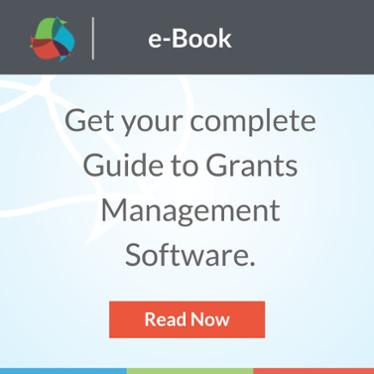 So, you’ve decided to start using grants management software or switch to a new grants management system at your foundation. Great! Your life is about to get a lot easier. But there’s a hurdle you need to clear before you take take the plunge: You need to convince your team that it’s the right move to make at the right time for your foundation. Pitching new technology can be daunting. We’ve been there. And making the case for implementing a new grants management system can be especially intimidating to those of us who don’t come from a tech background. That’s why we created this three-step plan to get your team to say “yes” to grants management software.
So, you’ve decided to start using grants management software or switch to a new grants management system at your foundation. Great! Your life is about to get a lot easier. But there’s a hurdle you need to clear before you take take the plunge: You need to convince your team that it’s the right move to make at the right time for your foundation. Pitching new technology can be daunting. We’ve been there. And making the case for implementing a new grants management system can be especially intimidating to those of us who don’t come from a tech background. That’s why we created this three-step plan to get your team to say “yes” to grants management software.
Step 1: Prepare to Address Your Team’s Concerns
“Change is always difficult,” says Wendy Yu Einhorn, senior grants manager at Pacific Foundation Services. “It might be difficult to go to a new system; [your team] might not understand.” In some cases the executive team and board might push back on the move, or at the very least, air their concerns.
But don’t despair: We surveyed foundation staff members (including Einhorn) and social sector tech experts who have already worked with their teams to implement grants management software. We want you to be prepared to address your entire team’s concerns, so we asked our experts what you can expect to hear from your team when it comes to purchasing and implementing the software:
- Cost: The software is too expensive.
- Resistance to change: Our system already works just fine.
- Implementation: The implementation process will take too long, and will be difficult.
- Security: Cloud-based systems aren’t as secure as in-house servers.
- Impact on grantees: A new online grants application is a hassle and a big adjustment for prospective and existing grantees.
These are all valid (if misguided) concerns. Remember, your team hasn’t done all the research you have on grants management software – you’re the expert now. You know, for example, that the benefits of using the software far outweigh the costs. You know that upgrading to a new system will help you do more efficient work and become more data driven. You know that with proper planning, good communication among stakeholders, and a focused long-term outlook, implementations aren’t a roadblock. You know that when you have your cloud-based system up and running, it will be very secure. And you also know that grantees will appreciate a more streamlined grants portal.
It’s important to compile your research into a digestible pitch that addresses each of these potential concerns, and outlines the benefits of using the software. Which brings us to:
Step 2: Understand the Benefits of Grants Management Software
“Even small grantmaking programs can have complex needs for keeping track of details. Having a good system to keep it all organized can save time, prevent mistakes, and improve the experience for reviewers and grantees,” according to Karen Graham, Executive Director of Idealware. And this is just a start.
To make the best case to your team, it’s important to go beyond only addressing their reservations. You’ll want to communicate the intrinsic, long-lasting benefits of grants management software. We collaborated with Nadia Alia, manager of grants and communications at the New Canaan, Conn.-based The Tow Foundation, and Graham from Idealware, to define these benefits for you:
- Grants Management software reduces the burden on grantees. Existing grantees’ information remains in the system; they spend less time renewing their applications. First-time applicants will appreciate the straightforward online application.
- Because most grants management software vendors offer cloud-based solutions, foundation staff can easily stay in touch with each other, and up-to-date on the progress of every grant – anywhere, any time.
- Your grants management system provides a holistic overview of your grantmaking. When staff members leave your foundation, their institutional knowledge remains in the system.
- Additionally, cloud-based software comes with a built-in IT team: This means that they are working tirelessly to back-up and protect your data. You are far less likely to tackle a data breach, or lose data in a crash when you are using cloud-based software.
- Adopting this technology streamlines work, and therefore frees up your staff’s time to concentrate more on mission and less on administration. Your grantees and beneficiaries are, after all, the reason you’re working in the social sector.
Step 3: Outline an ROI
“When an organization is using technology effectively, the results are greater than or equal to the resources invested,” Graham says in a recent article. “That’s what it means to have a positive Return on Investment (ROI).”
Measuring the impact or benefit of your grants management system can be difficult – it’s hard to ascribe value to intangibles, like efficiency, or grantee burden. But an ROI is a great way to view some of these qualitative benefits through a more quantitative lens. Graham’s article is a great comprehensive guide to walk you through it.
Essentially, your ROI should make the case that the benefits of implementing new grants management software will far outweigh the upfront costs. For example: your staff will spend fewer hours tracking progress on grants. Less time and effort devoted to certain tasks means your foundation is saving money. An “ROI should be a combination of cost and time,” Alia at Tow says. “Both are bottom line resources that are easy for board members to understand.”
Working with your entire team to achieve full buy-in is an important part of the entire process as you make a significant technology shift. As long as you’ve done your homework on the proposed technology, support healthy communication, and provide plenty of opportunities for stakeholder participation at all levels of the journey, your adoption of a new grants management system should ultimately make your life easier and your organization’s grantmaking more streamlined so you can stay focused on your mission.
“That's what we all want, right?” asks Graham. “Less paperwork, fewer chances for something to slip through the cracks, and more time to do the work a computer can never do for us – the kind of work that uses our creativity and our insight and our compassion.”
Eliza Smith is frequent contributor to Fluxx and the special projects associate at Glasspockets, a project of the Foundation Center, San Francisco.
